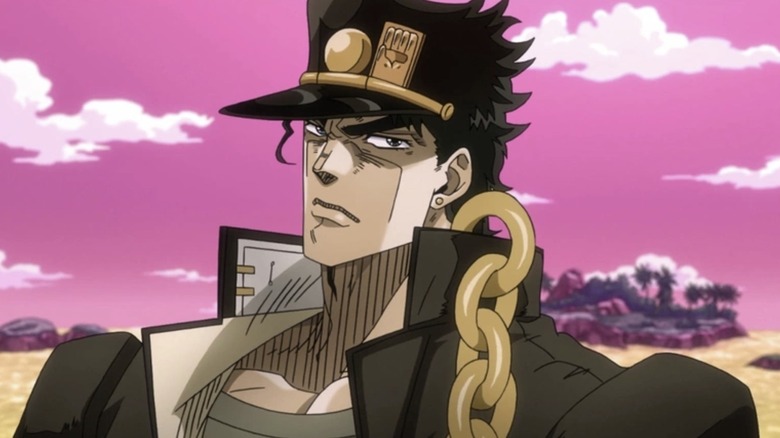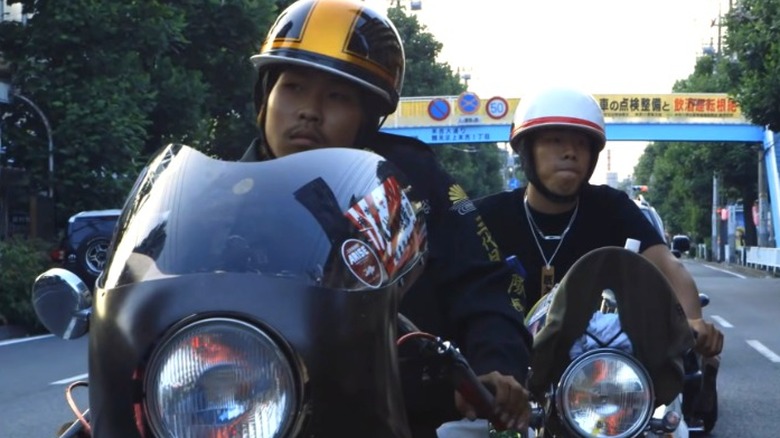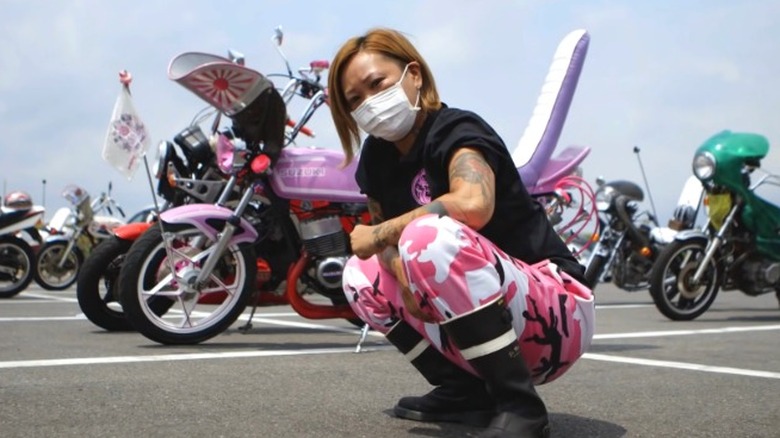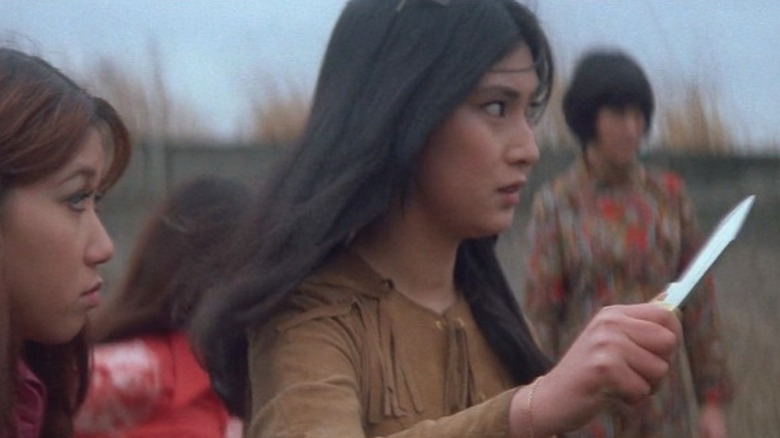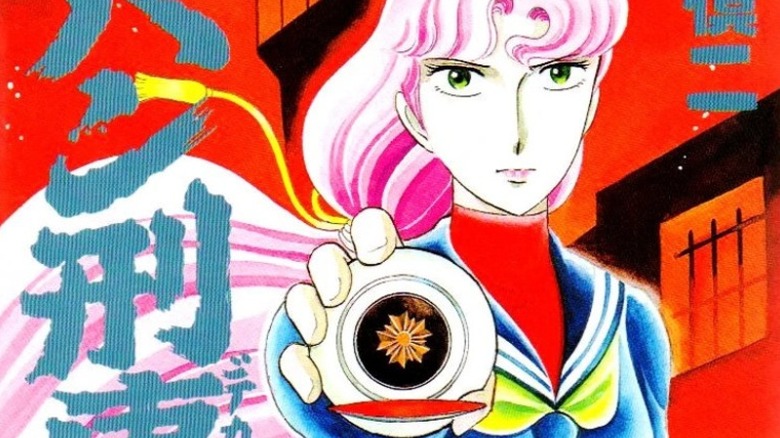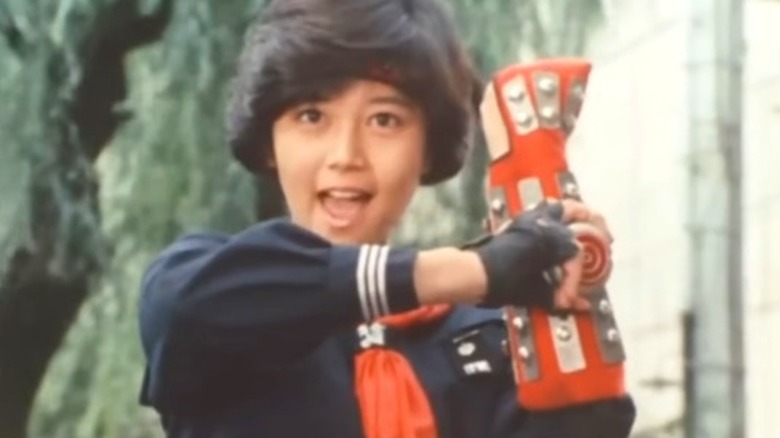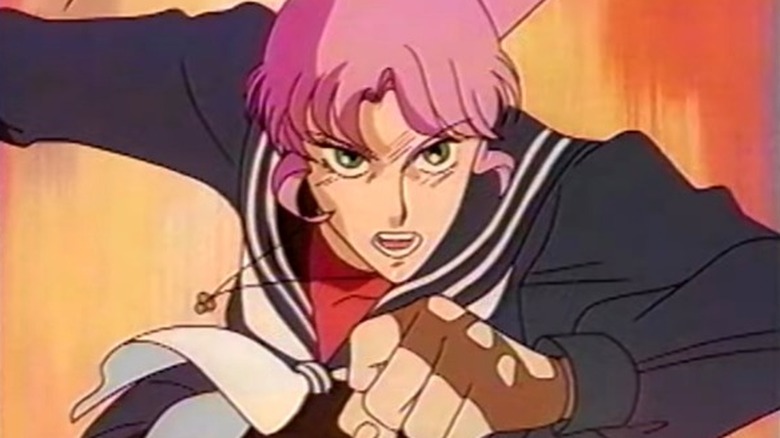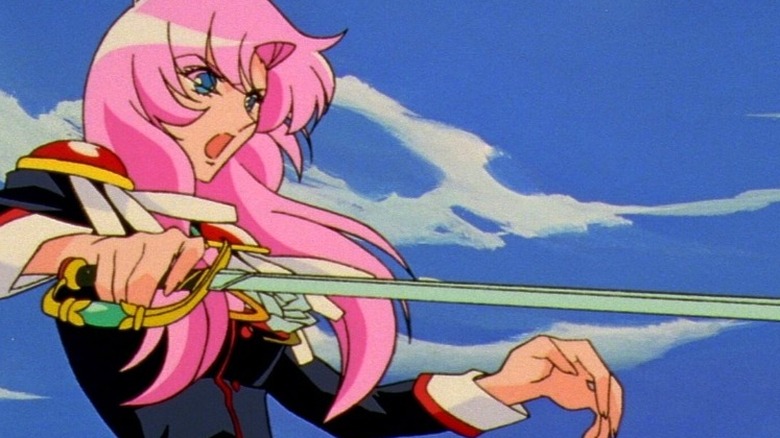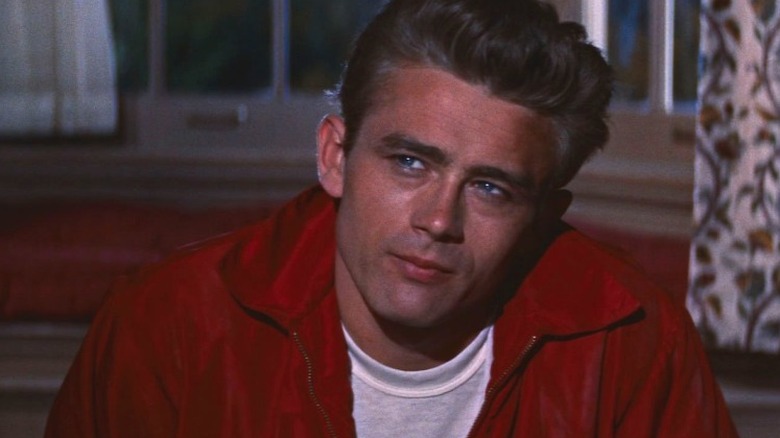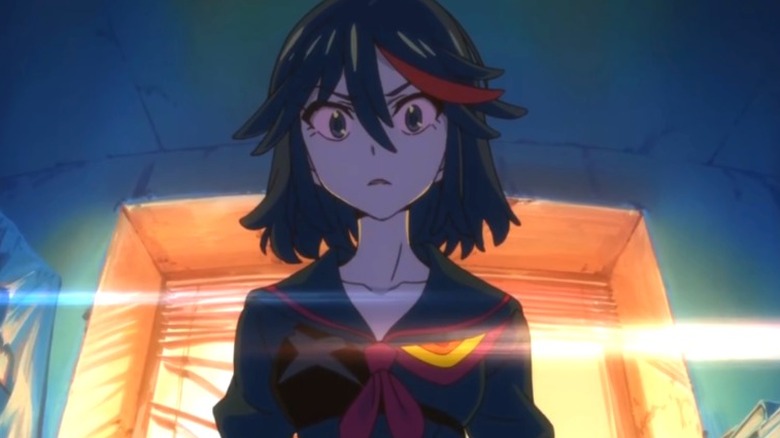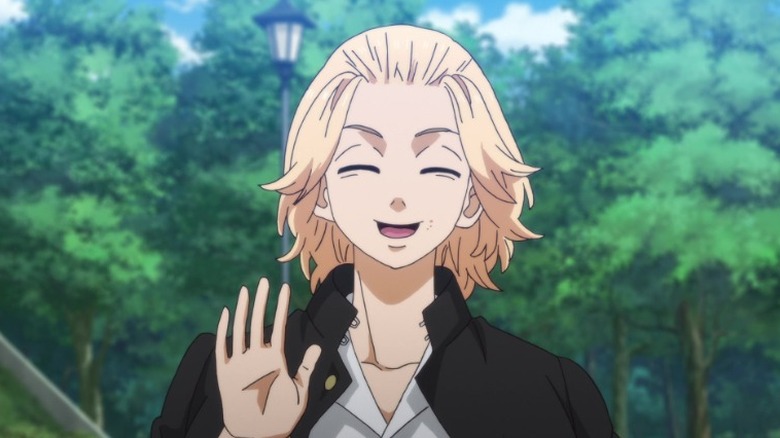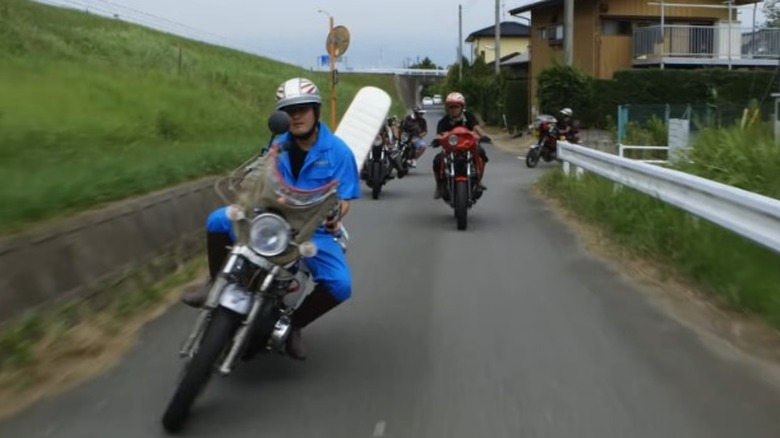How Real-Life Gangs Changed Japanese Cinema, Television, And Anime Forever
Anime is filled with unique characters, but if there's a type that is present in almost all subgenres, it's the classic high school delinquent. Iconic protagonists like Jotaro from "Jojo's Bizarre Adventure" and Ryuko from "Kill la Kill" are exaggerated examples of this archetype. They tend to wear uniforms that openly contradict school regulations, stand or sit in a defiant posture, and exhibit an aggressive personality while still following a strict code of honor. However, this type of character has been present in manga and anime since the 1970s, and it's based on real people.
Many fans don't know that these young delinquents' appearance and behavior are based on a cultural movement that emerged in the 1960s and 1970s, rebelling against traditional Japanese roles, sexism, and inequality. These yankii and sukeban gangs both scared and fascinated citizens. This inspired live-action exploitation films, manga series, tokusatsu TV shows, and eventually, anime series. Interestingly, the depictions of young delinquents continued to evolve and even influenced Hollywood directors. Let's introduce the world of yankii, bosozoku, and sukeban gangs, and their surprisingly persistent impact on Japanese cinema, television, and animation.
Decades ago biker gangs terrorized Japanese streets
In the 1970s and 1980s, Japanese citizens walking on the street at night were probably afraid of one thing. It would start with the roaring sound of dozens of motorcycle engines being pushed to their limit. The riders didn't look like traditional Japanese men. They dyed their hair in vibrant colors, wore long jackets, and wielded bats or wooden katanas while yelling threats at other drivers and pedestrians. The bosozoku, as they were known, were biker gangs that ruled the streets of Japanese cities, and people had good reasons to both fear and respect them.
The bosozoku were known for their violence, but also for following a strict code of honor. They would frequently taunt people and ambush members of other gangs, but they would also display tremendous respect for the older members of the group, and subject themselves to physical punishment if they offended their peers. Membership in a group like that would only appeal to young individuals with violent tendencies, which they found regularly in high schools.
Delinquent students, also known as yankiis, were usually seen wearing highly customized uniforms and adopting the sophisticated regent as their hairstyle. They were usually seen chain-smoking and fighting to prove their masculinity and saw their behavior as a continuation of the spirit of the samurai. As such, it wasn't easy for equally rebellious women to enter these groups, which is why they created their own.
A search for gender equality gave rise to the sukeban gangs
The sexual revolution of the 1960s had a notorious impact on Japan. Women felt more empowered, but society, in general, kept pushing for the adoption of traditional gender roles, like the classic submissive wife. Dress codes changed, and clothing like the mini-skirt became more widely used. Some young women started to get tired of these imposed roles. They didn't want their lives to revolve around becoming an attractive young woman, nor did they see growing up into a perfect wife as a reasonable life objective.
The response was a change in how young women behaved. They started by adding long skirts to their uniforms, wearing Converse sneakers instead of shoes, and sitting in a squatting position. Their objective was to rebel against the idea that young women should make themselves attractive to get a boyfriend. The new gangs, called sukeban or girl boss, also had a very aggressive attitude, frequently finding themselves fighting against other groups. As a result, they decided to hide knives within their clothes, and carry weapons like bamboo swords.
Sukeban gangs followed strict codes of conduct though. Depending on the gang, members would be subjected to physical punishment if they were found using drugs or cheating with someone else's boyfriend. This tough but fair environment was very attractive to young delinquents, and soon the gangs grew in numbers and even formed alliances. The largest of these, Kanto Women's Delinquent Alliance, for example, had approximately 20,000 members. With such numbers, it wouldn't be long before the groups caught the attention of film directors.
Pinky violence movies turned the movement into male fantasies
The increasing number of sukeban gangs only made them scarier. As encounters became more frequent, stories of the gang's crimes, love triangles, and revenge started to spread, reaching the ears of TV and film producers. Unfortunately, the topics were not appropriate for the dramas and anime series being broadcast at the time. It was, however, ideal for exploitation films.
Pinky violence was an exploitation subgenre that focused on sex, mobster violence, and female revenge. 1973's "Sex and Fury," for example, tells the story of a 17th-century, sword-wielding female gambler in search of the men who killed her father. "Female Yakuza Tale," the sequel released in the same year, focuses on a mystery revolving around yakuza. Both films are filled with gratuitous nudity and well-directed action scenes, which could be easily adapted to feature sukeban gangs.
Despite the erotic scenes and violence, sukeban pinky films would also focus on Japanese women demonstrating their ability to survive without men and fight back against a conservative society that wanted to assign them submissive roles. Movies such as "Stray Cat Rock: Delinquent Girl Boss" and "Terrifying Girl's High School: Lynch Law Classroom," featuring actresses like Reiko Ike and Miki Sugimoto, would focus on rival gangs realizing they were more powerful by joining forces against corrupt politicians or yakuza trying to control them. The result was that sukeban were transformed from feared thugs into antiheroes.
Sukeban manga series rebranded the genre for mainstream audiences
Sukeban pinky violence films didn't need a large budget, because they often employed non-professional actors in the roles of the women, who showed up in their own clothes, hairstyles, and makeup. This allowed studios like Toei to make numerous films. But while fans of the genre saw the stories as a tale of empowerment, others saw them as a glorification of violent gangs. In order for the genre to appear in other forms of media, it had to evolve.
Many elements from the real-world gangs' lifestyle had to be removed in order to adapt the genre for younger audiences. For example, the genre's first manga, Shinji Wada's "Sukeban Deka" or "Delinquent Girl Detective," portrayed a character who worked alone as opposed to being part of a gang. Realistic weapons like swords and bats were replaced by everyday items like a slingshot or darts, or simply martial arts skills as in "Tales of Yajikita College." Sex was replaced by mystery plots and comedic sidekicks.
Two mangas that appeared during the 1970s and 1980s are responsible for solidifying the most recognizable features of the genre. Both "Sukeban Deka" and "Hana no Asuka-gumi!" revolved around a girl who arrived at a new school, tried to solve a mystery, made some friends, and eventually faced the bad guy behind all the unusual occurrences. The weapons of choice became seemingly random objects given unexplained strength, like yo-yos, coins, or origami cranes. These elements would be taken to new levels of spectacle in live-action TV shows and movies.
Live-action TV shows turned sukeban into tokusatsu heroes
Japanese TV shows faced harsh competition in the 1980s. While an adaptation of the classic sukeban detective genre would provide younger audiences with a combination of drama, mystery, and action, the shows cast popular singers as their lead actors to ensure that the audience would tune in.
The first season of "Sukeban Deka" was led by singer Yuki Saito. But after she left the show to work on her singing career, the series had to cast another actress. This time, the story followed a different girl who adopted the name of the original Sukeban Deka, Saki Asamiya, as a codename. She was accompanied by two new sidekicks using marbles and martial arts as weapons, a sign of the progressively complex plots that other series would follow in order to maintain viewership.
During the next few years, new sukeban-like shows would emerge. "Hana no Asuka-gumi!" was adapted in 1988 into a TV drama, in which the protagonist has to use a golden coin to fight against enemies who use increasingly ridiculous weaponry ranging from bamboo stilts to boomerangs. "Sailor Suit Rebel Alliance" takes things even further, as three female students use a powerful scarf, sharp pencils, and gloves with metal knuckles to fight their enemies. If "Sukeban Deka" was at this point fighting ninjas and zombies, the girls from "Sailor Suit Rebel Alliance" were facing ghosts, teachers with mind-controlling powers, and mad scientists. It was, for all intents and purposes, a superhero show.
The live-action sukeban shows led to more anime adaptations
Sukeban live-action shows proved that the concept was appealing to audiences. As a result, it didn't take long for "Sukeban Deka" and "Hana no Asuka-gumi!" to get anime adaptations. These series would ignore the live-action changes and follow the original story and character designs. Sadly, for most people interested in the latter, getting a copy of these shows isn't easy.
The anime version of "Hana no Asukagumi!" is relatively unknown. The short series sees the protagonist develop a friendship with a young woman who was bullied, while also fighting a girl who raises and trains crows to attack her. There's also apparently an anime sequel to this called "Hana no Asukagumi 2: Lonely Cats Battle Royale," but copies are extremely rare. This is unfortunate, as the sequel has many things going for it, like the fighting championship of the title and an exploration of the protagonist's origins.
These adaptations were accompanied by the release of yankii anime series. "Sakigake!! Otokojuku," for example, adapted a manga about a school where students are taught how to become stronger men and follow an honorable path. "Osu!! Karate Bu," on the other hand, is a comedic take on the yankii genre, telling the story of a big student that is constantly being challenged by young delinquents, to the point that he decides to join the karate school club. As simple as these characters were, they would open the door for more complex character arcs in the following decades.
Yankii and sukeban characters improved manga and anime story arcs
The influence of sukeban and yankii characters can be seen in various anime productions from the 1990s. Sanosuke Sagara from "Rurouni Kenshin" is an excellent example of a period character, displaying the classic bosozoku jacket and bandages, who is later revealed to be a good person. This type of arc became a trope, exemplified by other characters like Yusuke Urameshi and Kazuma Kuwabara from"Yu Yu Hakusho." Protagonists like Utena Tenjou from "Revolutionary Girl Utena" have also been heavily influenced by the rebellious attitudes of young delinquents, only following their own path instead of the classic character tropes.
Probably one of the most important manga of the era is "Crows." It tells the story of Bouya, a young man who transfers to a school where all the problematic students are sent. Ironically, Bouya fights because he finds it fun, not because he hates people. Over the course of the story, we see the students become friends, and reflect on whether the path they are following will bring them happiness. It's a coming-of-age story that takes advantage of delinquent characters to inspire reflection.
Yankii culture continued to influence character designs like Jotaro Kujo and Josuke Higashikata from "Jojo's Bizarre Adventure." In addition, more yankii-focused comedies were released to great success, including "Great Teacher Onizuka," about a teacher who used to be a bosozoku, and "Cromartie School," a progressively surreal comedy that includes a Freddie Mercury lookalike, a gorilla, and a robot.
American and Japanese fictional rebels influenced each other
American culture seems to have played an important role in the development of the yankii subculture. James Dean's "Rebel Without a Cause" influenced its hairstyles, attitude, and clothing. Others have argued, however, that exposure to Americans from military bases, their wardrobe, and the music they listened to also had a strong influence. While some features of bosozoku and sukeban gangs like long white jackets or the squatting position respectively may seem uniquely Japanese, other elements like the use of huge pompadours, leather jackets, and the rebellious attitude seems to be proof of the influence of American movies. It's not a surprise then that the first to display this look were called yankiis by Japanese citizens.
The look and behavior of yankii and sukeban characters captured the attention of audiences for such a long time that they eventually went full circle and influenced American culture. The clearest example of this is the sukeban-inspired character of Takako Chigusa in the film "Battle Royale." The movie is admittedly one of Quentin Tarantino's favorites. In fact, he went as far as hiring the same actress, Chiaki Kuriyama, to play the chain-wielding schoolgirl Gogo Yubari in "Kill Bill Vol. 1." Another example of a sukeban-inspired character is Gazelle from the Matthew Vaughn film "Kingsman: The Secret Service." Gazelle, played by Sofia Boutella, might not wear the classic sailor uniform, but her clothing resembles some sort of school outfit, and her sword-carrying prosthetic legs look like something out of a sukeban live-action series.
Post-2010s anime gave yankii and sukeban characters a modern twist
The popularity of yankii, bosozoku, and sukeban characters kept the genre alive for decades, but by the 2010s, manga and anime writers had to come up with fresh takes to subvert audience expectations and provide interesting stories. Bakugo from "Boku no Hero Academia" is a great example, as the writers used his unbuttoned high school uniform and his tendency to bully other students to quickly establish his aggressive tendencies. However, as the series progresses, the audience discovers that his anger against Deku comes from a fear of weakness, and he eventually starts demonstrating his heroic tendencies.
Two characters from manga writer One are other excellent examples of the creative use of yankii characters. Metal Bat from "One Punch Man" displays the classic modified uniform, hairstyle, and disrespectful attitude, but when a threat emerges so does his heroic personality. Tenga Onigawara from "Mob Psycho 100" is presented as a classic young delinquent at Mob's school. But instead of establishing him as a bully, the character is used to demonstrate how easily people can turn their back on someone they already held specific beliefs about.
Ryuko, from "Kill la Kill," has a unique relationship with the sukeban genre. Her aggressive and skeptical attitude is used as a way to provide audiences with a point-of-view character who is increasingly surprised by the absurd traditions of Honnouji School. It's also a direct reference to the "Sukeban Deka" live-action adaptations, as she wears a similar uniform and red gloves, and the ending is clearly a shot-by-shot reinterpretation of the TV series finale.
Tokyo Revengers revitalized the young delinquent genre
Ken Wakui, writer and illustrator of the popular manga "Tokyo Revengers," has received a lot of praise for his work, but he wasn't always this successful. During his younger years, he spent time as a delinquent and hung out with gangs. When his coworkers found out about his past, they asked if he could write a manga based on his experiences. Wakui found the idea interesting, but he wasn't familiar with current gang subcultures. In order to create a story about the world he experienced as a teenager, he came up with a time-traveling narrative device. The result was a realistic portrayal of outcasts joining forces to prevent a tragedy.
The story of "Tokyo Revengers" revolves around Takemichi Hanagaki, a young adult who discovers one day that his high school girlfriend has been murdered. Soon after he finds out he can travel 12 years into the past, to when he was part of a bosozoku gang, and decides to use his newfound ability to prevent the murder. However, he quickly discovers that controlling the consequences of his actions is not as easy as he thought. The manga has been very well received, selling millions of copies, earning a Kodansha Award for Best Shonen Manga in 2020, and being adapted into a popular anime series. In other words, Ken Wakui's story has put young delinquent stories back in the eyes of the public, not just in Japan but around the world, setting the stage for a resurgence of the genre.
Today sukeban and yankii subcultures have declined significantly
Despite their once immense numbers, yankii and sukeban gangs seem to be, for the most part, a thing of the past. In an interview with a former bosozoku gang leader, it becomes evident that groups that used to have dozens of members, and belong to an alliance with thousands of bikers, today have trouble gathering more than five teenagers. The older members of the gangs have either died, been arrested, or gotten manual labor jobs like demolishing houses or fixing streets. Sukeban gangs, on the other hand, are apparently non-existent.
Some attribute the disappearance of the movement to the development of new law enforcement strategies. The police gradually reduced their numbers by collecting information about the identity and activities of the most dangerous members and then proceeding to arrest them. This severely reduced gang activity after the 1980s. Of course, that doesn't mean that Japanese youth haven't found other ways to express themselves.
The globalization of pop culture and the emergence of the internet as a means of communication mean that young Japanese men and women are now able to discover more niche interests and find people to share them with more easily. They can join a group dedicated to buying and modifying vans, or adopt a gyaru look that imitates Western clothing styles and tans. In other words, the need for aggressive acts of rebellion has disappeared, leaving teenagers with more socially acceptable but still unique ways of expressing themselves.
